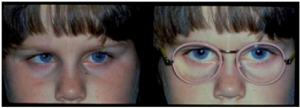What is accommodative esotropia?
Accommodative esotropia, or refractive esotropia, is one of the most common forms of strabismus (crossed eye). It refers to eye crossing that is caused by the focusing efforts of the eyes as they try to see clearly. Patients with refractive esotropia are typically farsighted (hyperopic). This means that the eyes must work harder to see clearly, particularly when the object of regard is up close. This focusing effort is called accommodation. The closer an object is to the eye, the greater the amount of accommodation that is required. A side effect of the accommodative effort can be excess convergence or crossing of the eyes.
Why is accommodative esotropia a concern in children?
If a child’s eyes cross at an early age, then vision will not develop normally. Vision can be permanently reduced in one eye if it is not “used” properly during childhood, and fine depth perception may never develop. If crossing of the eyes is diagnosed and treated early, then vision development can proceed normally. Crossing of the eyes is never normal (except for occasional crossing in the first three months of life), and any child suspected of having crossed eyes should be examined by a pediatric ophthalmologist.
Do all children with farsightedness have accommodative esotropia?
No, in fact most children are farsighted but the majority of them do not have any esotropia. Most children are only mildly farsighted, and thus the accommodative effort they make to see clearly is not significant. The more farsighted a person is, however, the greater the amount of effort they must exert and the more likely they are to cross their eyes. Therefore, while two individuals may have the same eye prescription strength, one may have eye crossing and the other may have perfectly straight eyes. Heredity plays a role in determining which children develop esotropia.
How is accommodative esotropia treated?
Initial treatment for accommodative esotropia usually involves the prescription of eyeglasses or contact lenses to correct the patient’s refractive error (hyperopia) [See figure 1]. By letting the eyeglasses do the work, the eyes can relax their focusing or accommodative effort. In turn, this will reduce the convergence or crossing stimulus and the eyes will straighten as they relax. Glasses or contacts which are used to treat accommodative esotropia should be worn full time.

Fig. 1 Initial treatment for accommodative esotropia usually involves the prescription of eyeglasses or contact lenses to correct the patient’s refractive error (hyperopia).
What happens after a child starts wearing glasses for accommodative esotropia?
Even after a child has been successfully wearing glasses to treat accommodative esotropia, it is still normal for the eyes to continue crossing without the glasses. In fact, the crossing may be even more noticeable than it was before the child started wearing glasses. The important thing is whether the eyes are straight and controlled with the glasses on. If the eyes are not straight with glasses on, then vision with two eyes will not develop normally. Your pediatric ophthalmologist is the best person to judge this and will give you feedback at follow-up examinations. These follow-up examinations are important not only to monitor the eye crossing, but also to check for associated problems such as amblyopia (decreased vision in one or both eyes which is common in this type of strabismus).
What role does surgery play in accommodative esotropia?
Surgery is indicated only if the eyeglasses fail to straighten the eyes while the glasses are on. In this case, eye muscle surgery (strabismus surgery) may be recommended to help improve eye alignment.. This surgery is usually done in childhood to help promote binocular vision development. Usually surgery for accommodative esotropia does not eliminate the need for glasses, but rather fixes the amount of crossing that is “left-over” when the glasses are on. The eyes will likely continue to cross when the glasses are off.
Why do some children with accommodative esotropia require bifocals?
In some cases, children will have particularly excessive amounts of eye crossing (esotropia) at near, such as while reading. This may occur even when wearing the correct glasses to correct their farsightedness (hyperopia) and they may have perfectly straight eyes when looking at distant objects. These children may benefit from making the lower, reading area of the eyeglasses “extra strong” in the form of a bifocal lens.
Can children outgrow accommodative esotropia?
Yes, children can outgrow accommodative esotropia. This usually happens during the grade school and adolescent years as a child becomes less farsighted. It is difficult to predict early in childhood whether or not any given child will outgrow their need for glasses.
Credits: Journal of American Association for Pediatric Ophthalmology and Strabismus